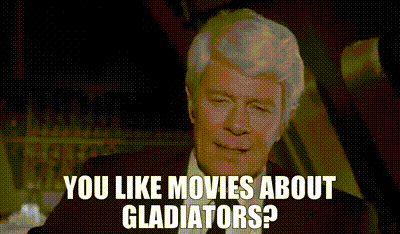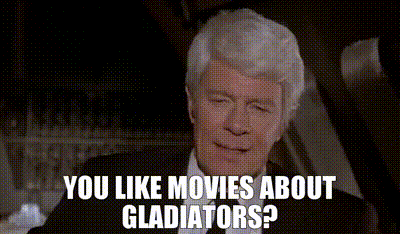Friends of Dave #370: ❤️ movies about gladiators 🏛️
Leaning into friction as a catalyst for change.
Friends, I guess my preamble last week (and subsequent post this week on LinkedIn) about getting 💩 done struck a chord — I received a ton of comments about it in my inbox, via text and in conversation with various people across my personal and professional network.
Mission accomplished.
PSA: as I have said here before, these preambles are usually a result of a variety of thoughts, conversations, observations and/or events that occur over a period of time. Sometimes ideas for them have been percolating for weeks/months/years before I get a chance to write things down. So, as a result, unless I mention someone specifically, THEY ARE SELDOM ABOUT OR A PASSIVE AGGRESSIVE MESSAGE DIRECTED AT ANYONE IN PARTICULAR….unless you happen to be one of my kids…or my Mom...but NEVER my wife….and then, yes, of course you should assume I am always writing about you. 😜
Now that we got that out of the way...
Sort of as a follow on to the GSD thread and the value of having people who get 💩 done….when 💩 is getting done, there sometimes can be an uncomfortable side effect (particularly if there may be a possibility of misalignment amongst a group): it’s friction.
Interestingly, while I have shared articles about friction in the FoD newsletter in the past (a few months ago I shared one about embracing friction), I don’t believe I have written about it specifically myself.
It may come as no surprise to regular readers or those who know me well that I’m a big believer that friction, if constructive and managed properly, can be an effective catalyst for change for those that do not shy away from it.
Here’s a story:
A number of years ago I joined the leadership team of a 20 year old public company to help turn things around and modernize the go-to-market messaging, the culture and the product offerings. It had been a relatively well respected company back in it’s heyday, but it’s growth had stagnated and it was in need of some TLC, improved technology, some fresh ideas and new blood.
I remember holding staff meetings with long time employees (many of whom were 5-10 years older than me) in those first few months where they offered detailed updates that highlighted how “we’ve always done things” and assured me that most of the new approaches we were considering with product, pricing and technology were simply not possible.
They had their points of view on what success looked like based on their experience. I had mine — and because I was brought in with an urgent need to drive and influence change, we had obvious misalignment. It was uncomfortable for everyone.
It was obvious that some of the people that were offering their opinions were set in their ways and okay with the status quo. As a result, they were reluctant to change their minds — and we certainly did not have time to convince them otherwise.
However, I did notice a bunch who I could tell were talented, thoughtful in their analysis, opportunistic and exhibited an interest in being open minded — they just needed some nudging.
So I decided to turn up the heat and increased friction amongst the group.
I openly challenged everyone to think differently — and with more urgency. I asked “why?” and “why not?” a lot, insisted everyone poke holes in conventional thinking and beared down on assumptions that did not seem airtight (even if philosophically I agreed with them). I gave everyone a heads up that there would be friction and that it would be uncomfortable, but reassured that this friction, while not always fun, was healthy.
A few times I remember using a tactic I had learned from a previous boss that she referred to as “throwing a grenade in a room” — I set an aggressive goal that seemed out of reach and asked the group to be accountable to drive to a specific result (usually within a short timeline)….and then I stepped back and watched how the team reacted to it.
The objective wasn’t for me to be right. It was to get stuff done, be opportunistic and drive the urgent change we needed. I knew it would not be a linear process. I also didn’t expect an unrealistic result to be delivered with perfection — but I did want to see if something better could come from the exercise, people would come out of their comfort zones and we could all align on some new directions.
And we did.
We killed a few products, once considered “sacred cows,” that were distracting and no longer successful. We adopted new higher pricing that better matched value in the marketplace. We developed and aligned on a hypothesis of what we did better than anyone else that opened up new opportunities on the product roadmap. We reorganized the team around people’s talents and strengths. More importantly, we developed a foundation for a culture that had more of a “growth mindset” and would be open to adapting to new ideas and directions (this would come in handy later when we sold the company and needed to integrate into an even older, stodgier parent company).
Those “that’s how we always do things” people that didn’t align with the new direction soon left — most on their own, a couple with a respectful invitation. Those that remained were stakeholders in the new vision we had built together.
Here the thing: the majority of people do their best to AVOID friction in their interpersonal interactions. They erroneously assume it means, because there is discomfort, there is discord or negativity.
They forget that friction is how the oceans are able to make a rock smooth.
Friction forms diamonds.
Friction is how a figure skater is able to glide on ice.
Friction helps a Formula 1 car to stay on course while it speeds around a winding track.
Friction allows an instrument to create a melody and become an earworm.
When it is controlled, focused and purposeful, friction can lead to beautiful things.
Especially when you are trying to get work sh^t/personal sh^t/creative sh^t/parenting sh^t done.
Think about how you view friction. If this gives you a different perspective on it… once again, mission accomplished.
XOXO
Dave
And now a few things to make you smarter…
The amount of data created each year has skyrocketed from 2 zettabytes in 2010 to 44 zettabytes (44 trillion gigabytes) in 2020. This has surged demand for data storage and processing, leading to the construction of massive data centers around the world.
So, where are the biggest data centers? 2023 data from Cushman & Wakefield sheds light on the biggest data center markets.
Failure is only good for you if you learn how to handle it. To do that, here are six concepts to think about in the wake of a setback. They make it easier to learn from, cope with, and bounce back from any failure.
The quintessential Roman spectacle, originally a way to honor the dead, was not Roman in origin.
The original Macintosh computer may seem quaint today, but the way users interacted with it triggered a revolution 40 years ago. What began as Apple prioritizing the squishy concept of “user experience” in its 1984 flagship product is, today, clearly vindicated by its blockbuster products since.
“No one invented the hard shell taco”
The hard shell taco is a beloved part of Mexican cuisine and a regular on Tuesday night dinner tables these days. So where did they come from, and how did this Mexican food staple become the symbol of fast Mexican food? Because while Taco Bell didn’t invent them, they sure did exploit the hell out of them.




